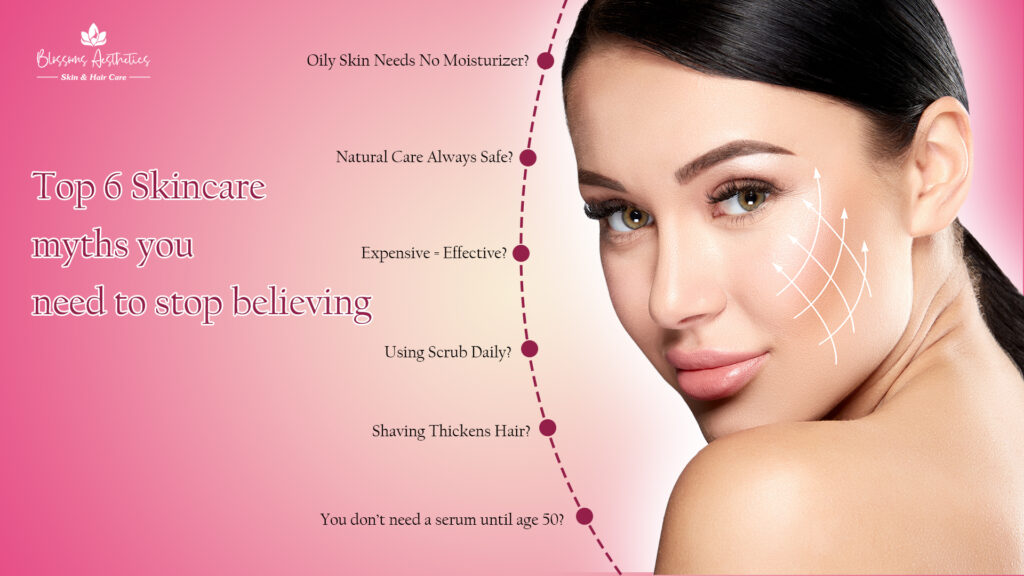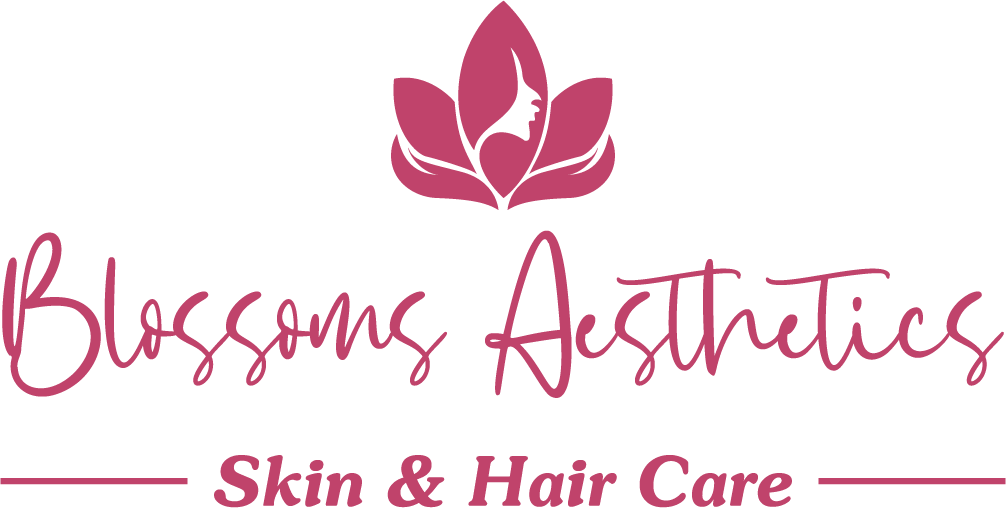
Understanding: Skincare Myths
There is much misinformation circulating regarding skincare. Many individuals unknowingly follow Common Skincare Myths passed along for generations regarding DIY hacks, old wives’ tales, and so on. There are so many influencers who tell us about the thing that works on their skin and recommend skincare without any prior knowledge.
How do you differentiate between skincare myths and facts? Do you need to forgo moisturizer if you have oily skin? Does toothpaste help with pimples?
It’s time to put to rest all these fake beautifying concepts. It’s time for science-backed skincare practices and healthier, Glowing skin. Let’s unmask some common skincare myths and know what works.
Top 6 Skincare Myths:
Myth 1: Oily Skin Doesn’t Need Moisturizer
One of the biggest skincare myths is that someone with oily skin does not need a moisturizer, since a moisturizer may contribute to a shiny complexion. In reality, not using a moisturizer can make oily skin worse Without moisturizing the skin, oil glands become imbalanced, which means your skin overcompensates and can produce more grease and, eventually, breakouts. Oil-free, lightweight gel moisturizer can maintain your balance with your skin. The moisturizers would not cause blockage on your pores.
Instead of skipping moisturizers, choose products with hydrating ingredients with hyaluronic acid and niacinamide or the best moisturizer for oily skin is a gel-based moisturizer as it hydrates the skin without making it feel sticky. These retain moisture, enhance skin health, and maintain oiliness. Oily skin also craves moisture the right one, of course.
Myth 2: Natural skincare products are always safe
While natural skincare products advertise themselves as safer alternatives, the truth is more complicated. Many consumers believe in the skincare myths that everything natural is just safe, period. That’s far from the case; many natural ingredients contain things like essential oils and citrus extracts, and some plant-based compounds can cause.
One of the best examples is Multani mitti (Fuller’s Earth) which is very good for the skin and everybody should use it but it can be damaging for dry skin as it can rip off all the moisture from the skin leaving it flaky. One shouldn’t just take it for granted that anything from nature is safe, so checking on the ingredient lists, patch-testing, and referring to a dermatologist is of the essence in this regard.
Myth 3: You must exfoliate every day
Probably, the most common misconception regarding beauty routines is that one must exfoliate every day to attain smooth, glowing skin. The truth, however, is much farther from it. Over-exfoliating could strip your skin of its natural oils, making it look more irritated and reddish with more breakouts on the face. Our skin has a natural mechanism of shedding dead cells, which excessive scrubbing can interfere with, thus weakening the skin’s barrier.
Exfoliation depends on the skin type. In oily or acne-prone skin, 2 to 3 times a week will be fine. Dry or sensitive skin will be even more cautious. Micro-tears caused by daily usage of harsh physical scrubs will never be helpful, whereas chemical exfoliants such as AHAs and BHAs are best used with care.
Skincare requires a balance. Instead of following outdated advice, trust Dermatologists, along with science and skincare myths busted—exfoliation is essential, but moderation is the secret to healthy, radiant skin.
Myth 4: Skincare products need to be expensive to be effective
Many people believe that skincare products need to be expensive to be effective, And that is where this is the biggest skincare myths and facts must be broken into. Luxury brands in skincare offer the best kind of packaging as well as strategy in marketing. But the key lies in what’s inside that doesn’t make any difference, not its price tag.
Affordable skincare products containing scientifically proven ingredients, such as hyaluronic acid, retinol, and vitamin C, are ingredients that are helpful for the skin if applied according to skin type and the right amount.
So basically, the trick is checking the ingredient list and choosing a product that would suit your type of skin rather than the price. All it comes down to is consistency.
Myth 5: Shaving will make hair grow back thicker.
The most common skincare myths debunked is that shaving your hair makes it grow back thicker or darker. However shaving does not affect your hair in any way will change its texture, color, or growth rate. When you shave, the razor cuts hair on the surface, so with each haircut, you add a blunt edge. The blunt tip, when growing out into the surface, can feel coarser or look darker, but it is not thicker or denser. The natural growth cycle of hair remains unchanged, regardless of shaving.
This myth has been passed from generation to generation, making people hesitant about shaving. However, dermatologists confirm that shaving is a safe and effective method for hair removal. If you prefer smoother skin, exfoliation and proper moisturizing after shaving can help maintain softness. Understanding skincare myths allows you to make informed choices and avoid unnecessary worries about hair removal techniques. But after knowing this females avoid shaving in that case you can choose laser hair removal.
Myth 6: You don’t need a retinol until age 50.
One of the many skincare myths is that retinol should be introduced only at the age of 50. Dermatologists, however, contradict this; they encourage everyone to introduce retinol to their skincare routines as early as the mid-20s or even the early 30s. The powerful derivative of vitamin A boosts collagen production and reduces fine lines, thereby creating a better skin texture. Waiting until age 50 may prevent you from reaping the compound’s preventive benefits.
Early application of retinol can delay the process of aging, diminish acne, and also help even skin tones with time. However, the concentration level of retinol must be low and gradually increased to avoid irritation. Also, its application with sunscreen is essential because it would make the skin sensitized to UV rays. Debunking this creates a significant difference in the choice of skincare routines adopted by various people and keeps their skin looking younger for longer periods.
The ideal age to start using retinol depends on your skin type, concerns, and overall skincare goals. However, dermatologists generally recommend incorporating retinol into your routine in your mid-20s to early 30s for preventive ageing benefits.
Conclusion: Skincare Myths
It is very important to understand the truth behind skincare myths and facts to ensure that one only decides on the right skincare routine. Many people believe in common misconceptions, such as only expensive products are good, shaving makes hair grow thicker, etc. In reality, skincare works in a manner like choosing the right ingredients, maintaining consistency, and protecting the skin from environmental damage.
Debunk each skincare myth to get healthier habits and avoid unrequired skincare mistakes. For best results visit a dermatologist and tell them about your concerns. According to your concerns, a dermat will suggest products and ingredients that will best suit your skin. Stay educated and embrace a skincare routine based on facts, not fiction.
